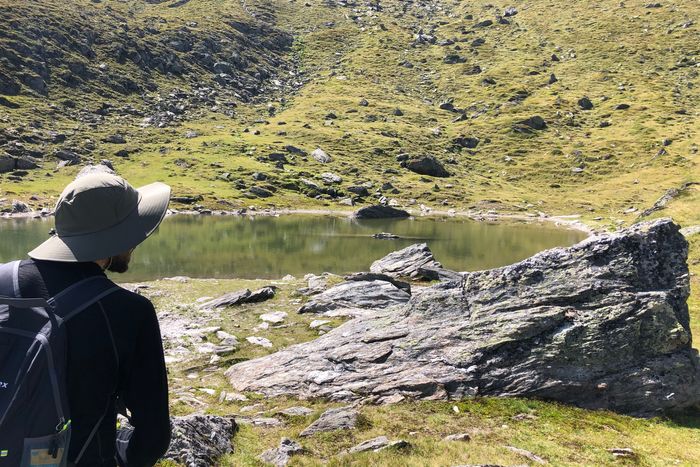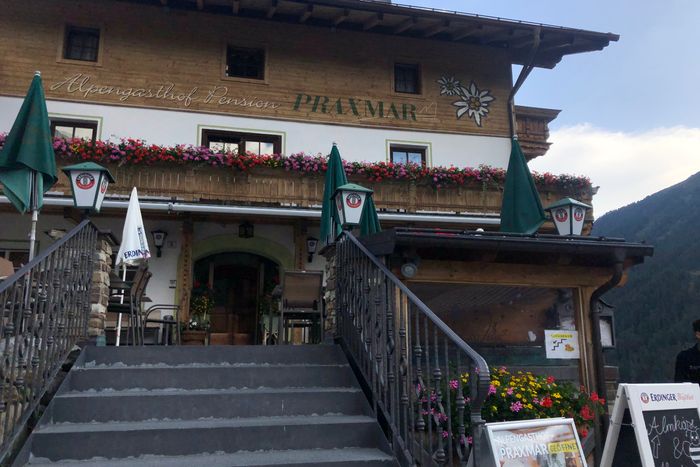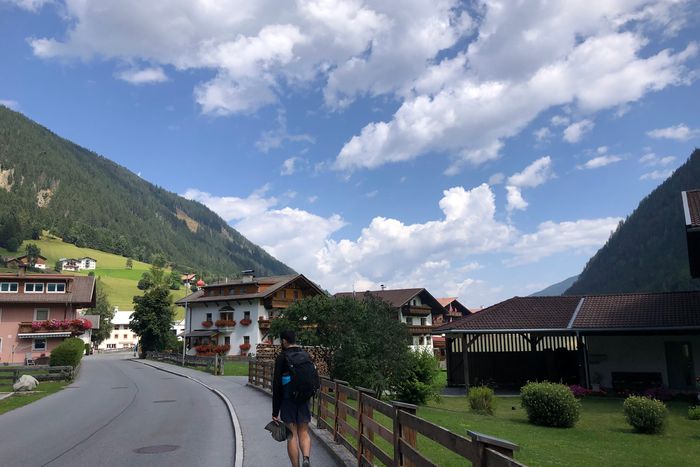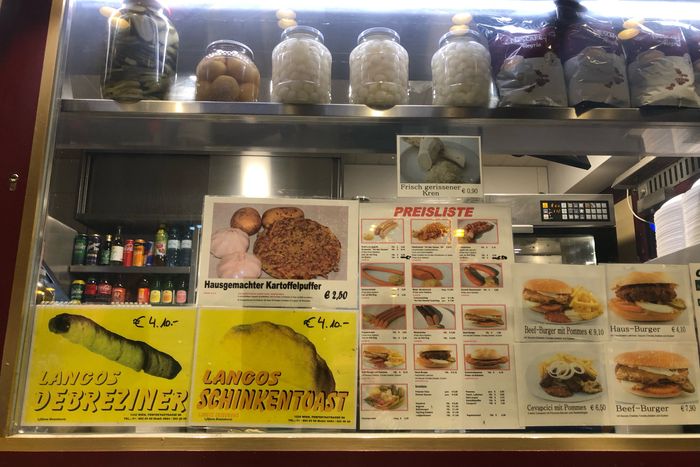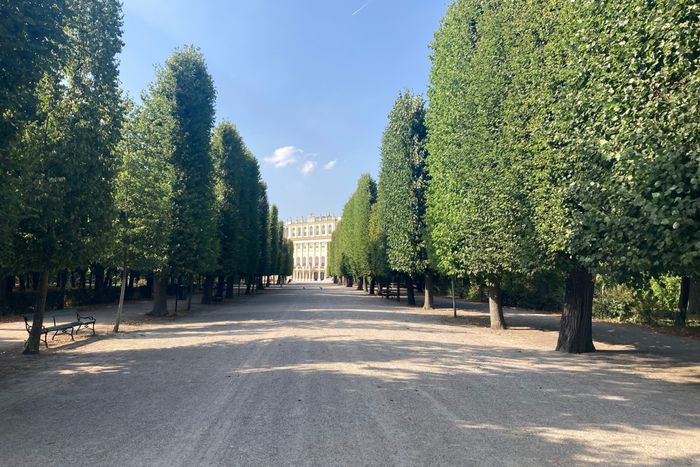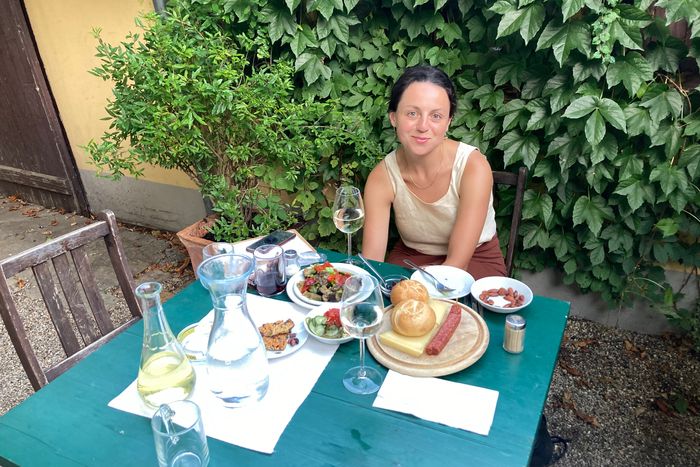I Hut-to-Hut Hiked Through the Austrian Alps for 5 Days
Mountaintop beers, roaming goats, and homemade strudel.

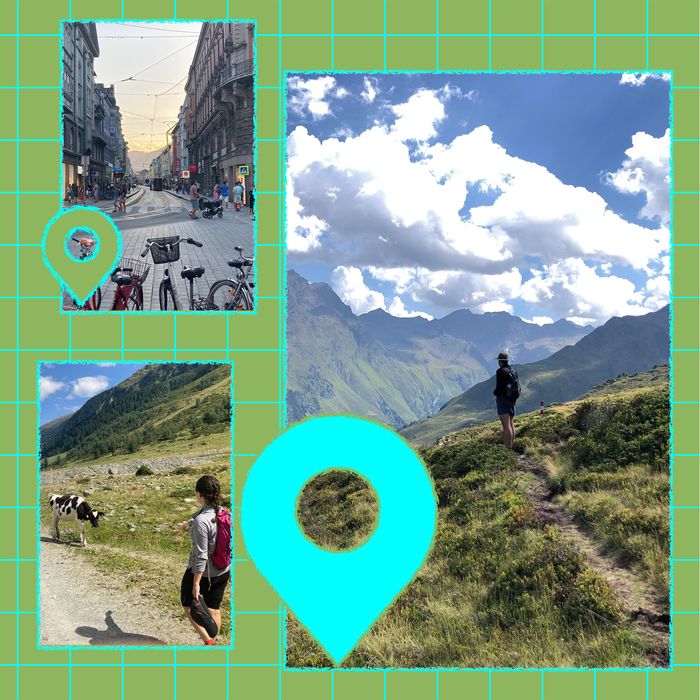
Photo-Illustration: The Strategist; Photos: Kayla Levy
Everyone knows that person who spends weeks sniffing around travel blogs, going deep into Tripadvisor rabbit holes, collecting Google docs from friends of friends, and creating A Beautiful Mind–style spreadsheets to come up with the best vacations and itineraries possible. In this recurring series, we find those people who’ve done all the work for you and have them walk us through a particularly wonderful, especially well-thought-out vacation they took that you can actually steal.
I’m the kind of traveler who will take a mountain over a museum any day, and thankfully, so is my partner, Jack (our first date was a hike). In August, we went on our first international trip together, which, quite fittingly, was hut-to-hut hiking in the Alps, a travel bucket-list item I first learned about in college. Hut-to-hut hikes (which exist internationally but are most well-known in Europe) are multiday treks between fully appointed lodges — the appeal of which is a plush bed, warm shower, and home-cooked meal after a long day of hiking. Also, unlike traditional backpacking, you don’t need to carry much gear.
Since popular Alpine huts are known to fill up six months in advance, we started planning our route in January (using European outdoor sites for guidance) and eventually settled on a 31-mile section of the Stubai High Trail, a well-trafficked, high-alpine route outside Innsbruck, Austria (cheaper and more convenient than options in Switzerland or Italy). Next, we joined the Austrian Alpine Club, a $115 membership that guarantees mountain rescue in case of emergency and affords a discount at most huts. Finally, we booked the huts, prioritizing those with single rooms, a slightly more expensive, but private, option than communal dorms (still, no nightly stay was over $80 per person, including dinner and breakfast, known as “half board”). As this was my first trip to Europe, we tacked on an additional 72 hours in Munich and Vienna.
Although I’ve hiked in the Sierras and backpacked in British Columbia, trekking through the Alps was my most challenging trip yet (made more difficult by some of my gear choices and the fact that we chose an alpine route). One fellow hiker, an experienced mountaineer from Berlin who was surprised to see non-Europeans on the trail, put it like this: “There are American hikers, and then there are hikers.” Still, with the right gear and preparation, it’s well worth it for the friendly cows, cozy huts, and breathtaking views.
We took an overnight flight from Newark to Munich via Stockholm, a trip that took about 14 hours, including a four-hour layover (if you’re willing to shell out a few extra hundred dollars, United operates direct flights from Newark and JFK). Our plan was to sleep on the flights and land feeling refreshed enough to spend an afternoon exploring the city. In reality, we landed in desperate need of coffee. After guzzling some in the airport, we hopped on a one-hour train ride to the hotel (the S-Bahn commuter rail ran notably smoother than NJ Transit).
We stayed at the MK Hotel Max-Weber-Platz (Einsteinstraße 34, 81675) in Au-Haidhausen. It’s a neighborhood on the west bank of the Isar that’s relatively shielded from tourists but still walking distance (25 minutes) from the old town. The MK has some quirks. For instance, the wall separating the bedroom and bathroom in our room was partially glass, lending itself to very little privacy in the shower. But, as far as budget hotels go, it fits the bill (which was a steal with credit card points). After cleaning up, we were ready to walk around.
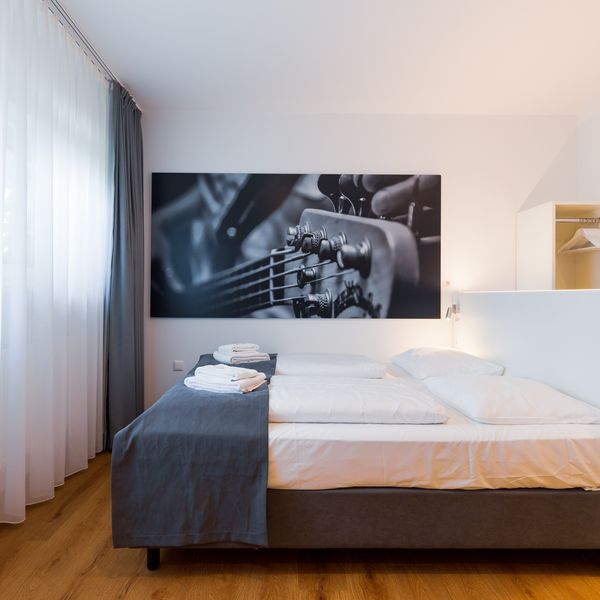
With only one evening in Munich, we set out to experience the best the city has to offer: beer and historic buildings. Our first stop was Biergarten am Muffatwerk (Zellstraße 4, 81667), a leafy, certified organic beer garden abutting the Isar. Many locals arrived straight from a swim, towels and all, to drink a pint in a cabana chair. We ordered two half-liter pours of Lammsbräu Urstoff, a Bavarian lager, and ate olives with feta, sauerkraut, a pretzel, and a sausage (I’m a vegetarian, though I toe the flexitarian line on vacation). Next was a stroll through the old town, including a stop to admire the Hofgarten, a Renaissance-style garden on former Bavarian palace grounds, and Gothic municipal buildings at the Marienplatz (a city-center square). The night ended at Hofbräukeller (Innere Wiener Straße 19, 81667), a gigantic beer garden where we drank more beer (you can’t buy anything less than a liter in the evening) and tried obatzda, a Bavarian cheese dip reminiscent of pimento cheese. Five miles and five hours later, we fell fast asleep.
After a slow morning people-watching and nibbling on pastries at Café Am Max-Weber-Platz (Max-Weber-Platz 11, 81675), we took a 45-minute train to the Dachau concentration camp Memorial Site (Alte Römerstraße 75, 85221). As a Jewish person who had never been to Europe before, it was important to me to bear witness to the legacy of the Holocaust. The Dachau Memorial Site is free and spans the grounds of the former concentration camp. Audio guides and group tours are available for under $5, and a comprehensive 40-minute English documentary plays three times per day. We opted to see the documentary at 11:45 a.m. and spent about an hour walking through the educational exhibits and religious memorials. I found the visit to be equal parts informative and emotional.
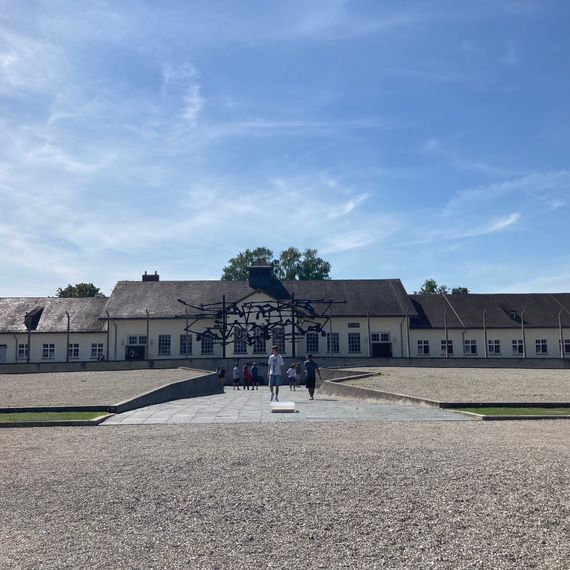

Once back in the city, we picked up a döner kebab, falafel salad in a box, and spinach hand pie from a casual Turkish spot and walked ten minutes to eat on the bank of the Isar. The water near us was only calf-deep, but parts of the Isar are popular for swimming and surfing, though not for the faint of heart: The river is only 60-something degrees during the height of summer, and there are powerful currents. After lunch, we waded in to cool off. Before heading to the train station, we stopped at Aldi to stock up on snacks for the hike, including a regional blend of Haribo gummies and lots of sandwich materials. Keep in mind, though, that you have to pack out all of your trash.
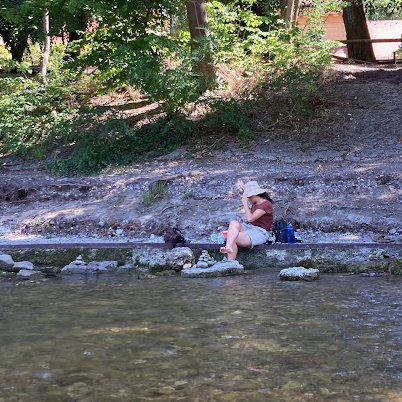

We arrived in Innsbruck at 6:30 p.m., the perfect time to drop our backpacks at the (clean and conveniently located) Pension Stoi Guesthouse (Salurnerstraße 7, 6020) and see the city in the final bit of daylight. Innsbruck is exactly how I imagine Aspen, Colorado, to be. A popular destination for Italian and German tourists, the city (which is the capital of Austria’s western state of Tyrol and the site of Swarovski’s headquarters) is riddled with upscale boutiques and ski resorts all set to the striking backdrop of the Alps.
After walking through the historic Altstadt neighborhood to marvel at a 15th-century gilded roof and baroque houses turned boutiques, we crossed a bridge into the quieter (and cheaper) Mariahilf-St. Nikolaus district for dinner. Knowing we’d be eating Tyrolean food for the next five days, we shared baingan bharta and palak paneer at Rama Indian Restaurant (Innstraße 81, 6020). It was carb-heavy and salty — an ideal pre-hike meal.
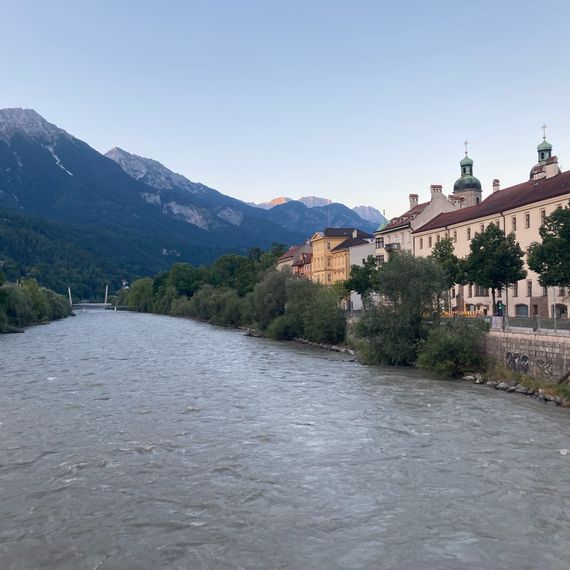

From Innsbruck, it’s a 45-minute ride on the 4166 bus to Saint Sigmund im Sellrain, a small village in the heart of the Sellrain valley where our hike began. The bus leaves at 8 a.m., 9 a.m., and 11 a.m. daily. After eating some pastries and packing up, we caught the 11 a.m. bus (though I’d recommend going earlier to avoid the afternoon heat). The day’s 4.5-mile trek, which follows the Gleirschbach River through a picturesque valley dotted with friendly cows, sheep, and goats, took us five hours (including a lunch break and many stops to pet the livestock). Although technically simple — all but the last half-mile or so is on a gravel fire road — the hike sees 2,600 feet of elevation gain. For context, that’s double the elevation gain of Breakneck Ridge, often considered one of the more challenging routes in the Hudson Valley. All well worth it for the breathtaking views.
Pforzheimer hut is a cozy wood-and-stone structure perched atop a hill right next to the Gleirschbach. For reasons I still can’t quite figure out, the hut has a subtle Buddhist vibe, perhaps the Tibetan prayer flags that hang around the perimeter and an altar on the second floor with a Buddha statue where incense is burned at night set the tone. The communal bathrooms and bedrooms are also on the second floor. On the first floor is the communal dining room and gear room for drying clothes and stashing boots, which cannot be worn inside any hut (they’ll all have slippers for you to borrow). Around the back is an outdoor terrace, where, after a shower, I joined Jack for several beers and a slice of homemade apricot strudel. We chatted with some fellow travelers and got a helpful tip about how to stick to the trail (instead of off-roading as we’d thought necessary) the following day.
I’m the kind of person who will eat anything while on the trail (I once gleefully chowed down on tuna-jelly-mustard-cheese sandwiches while backpacking). Still, it was the height of luxury to be served a multicourse, home-cooked meal after a long day of hiking. Dinner, which began promptly at assigned tables in the communal dining room, was carrot-ginger soup, salad with fennel and seeds, pasta (meat for Jack and spinach for me), and chocolate quark crème, a yogurt-like German dessert. We paid for our stay in cash before bed (as required at all the huts) and fell asleep by 9 p.m. to the sound of cowbells.
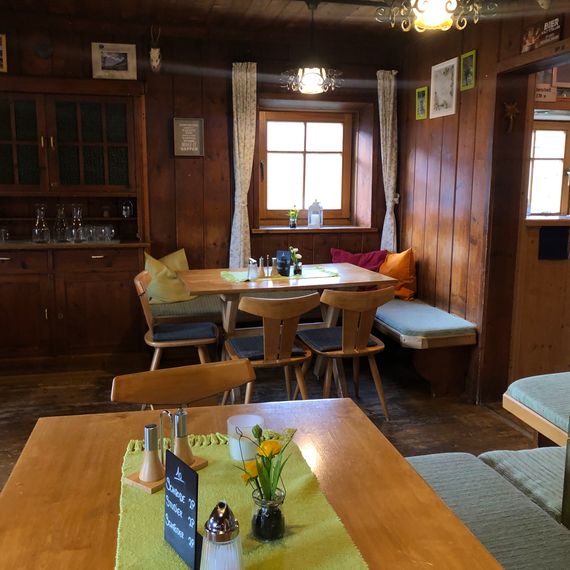

After an early wake up (6:30 a.m.) and a fully loaded breakfast buffet of bread, sliced cheese, meat, muesli, yogurt, and spreads, we set out to the second hut of our trip. This hike of just over four miles ended up taking eight hours. The trek took all day for two reasons: (1) As you will see is a pattern, we took our time — stopping to admire the views, pet cows, and eat snacks; (2) the hike was the most difficult of our trip (for me, not Jack).
After descending into the valley and climbing a steep but well-marked dirt-and-gravel path through the Stubai Alps, we hit scree fields (sections of unstable, broken rock), ascending the 10,000-foot Zischgenscharte pass. Here, the trail is only partially marked with cairns, and you have to use ropes and cables on the last two-thirds of the scree field. In Jack’s defense, I made the whole ordeal longer by having a mini breakdown and then leaving my bag partway up the pass, requiring him to go down and grab it. In my defense, the gully is very steep, and it’s hard to hike in scree, especially without proper gear. If I were to do it again, I would wear hiking boots, carry poles, and try to maintain better form (keep your nose above your toes and keep going, as the adage goes) instead of cowering on the rocks. At the top, there’s a striking view of the entire mountain range, and the dirt path down was steep but (mercifully) well-marked.
Descending into the lush valley surrounding the Westfalenhaus hut was a scene straight out of The Sound of Music (and laying eyes on it after our day of hiking had me more excited than the von Trapp children reuniting with Maria). The two-story hut was renovated a couple of years ago and sleeps nearly double the number of guests as at Pforzheimer. All of the communal spaces — the dining hall, outdoor terrace, bathrooms, and gear room — are on the first floor, and the bedrooms are upstairs. Ours had a bunk bed and window overlooking the valley. After settling in, we toasted our arrival with a couple of half-liter pours of hefeweizen (a German wheat beer) on the terrace, which has panoramic views of the Stubai Alps.
Here, dinner service was a bit more casual, beginning at 7 p.m. with the option to choose your own seats. We cozied up in wool blankets and ate on the terrace, watching the sunset throughout the valley. The three-course meal consisted of potato soup with big, homemade croutons (my favorite food of the trip), followed by sweet potato curry for me and a pork dish for Jack. Since Westfalenhaus is a more remote hut, it serves fewer fresh vegetables (those that we ate were cooked from frozen), but the food tasted good nonetheless. Also, in an effort to reduce food waste, the portions are small, but you can always ask for seconds. Dessert, a highlight for us both, was Bavarian crème and berries.
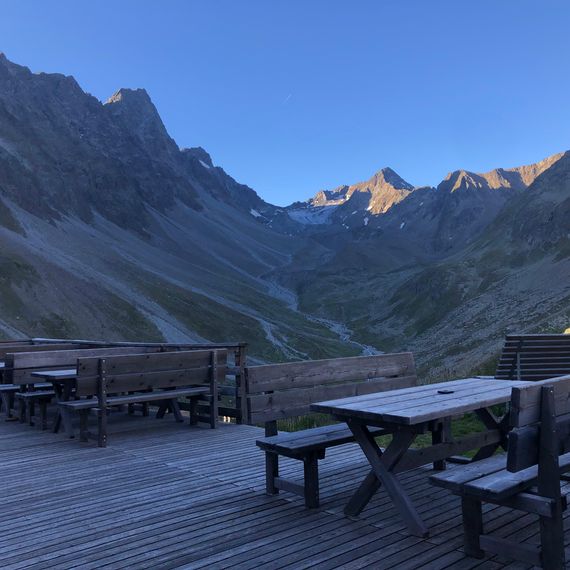

Another early morning (6:30 a.m.) and breakfast buffet, this one with stand-out mini pretzel rolls in addition to all the typical fixings. We stayed at Westfalenhaus for two nights, so this day’s hike was sans backpacks — and it showed. All told, we covered eight miles and about 3,600 feet of total elevation gain (the most in any one day) in less time than the previous day’s hike. The bulk of that climbing was up to the Hängebrücke Horntal, a recently opened waterfall suspension bridge partway up the towering Lüsener Fernerkogel, known as “the Matterhorn of Tyrol.” Most of the hike was on a well-marked path next to a river, and up the mountainside, but toward the top, you have to scramble up some steep metal ladders and grab onto metal ropes. At the bridge, there are sweeping views of the valley, though I was preoccupied with the intense sound of the waterfall.
The loop back to Westfalenhaus took us through the Lüsener Valley, past educational posters about climate change–induced glacial retreat and many friendly animals. There was also a stretch of trail covered in raspberry bushes (which, after confirmation with an app on Jack’s phone, we ate from). There was plenty of time to hang out at the hut before dinner, so we drank beer, ate a hearty slice of apple strudel, and read on a reclining chair overlooking the valley.
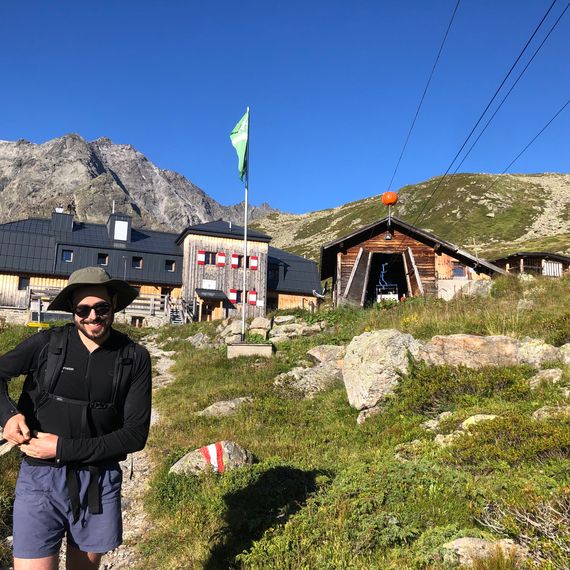

It’s typical for the Alpine huts to have a collection of books and games, seemingly amassed from many countries over the years. Very few were in English, so we opted for dominoes and played over the dinner of pumpkin soup and chicken (for Jack) or gnocchi (for me). Bavarian crème with berries was for dessert once again. Let the record show that I won the match.
After breakfast, we bade farewell (auf wiedersehen, good-bye!) to Westfalenhaus and set off on a three-hour hike into Praxmar, a small alpine village where we planned to stay the night. The four-mile route was almost entirely downhill and reminiscent of the Pacific Northwest, a welcome respite for these two West Coasters. Upon arrival, it was time for a second breakfast of berry–poppy seed cheesecake and Almdudler, a popular herbal Austrian soda.
It was too early to check in to the guesthouse, so we swapped our backpacks for day packs and hiked to the Bergersee, a small alpine lake. Like the morning route, the short (three-mile) hike was mainly forested but this time entirely uphill. Also, the final stretch through the hillside is marked only by cairns, so I’d recommend downloading an offline trail map to steer you in the right direction. We got to the lake in the heat of the day and went for a quick skinny dip. With no one but a herd of goats to see us, I figured it was okay.
Not a true Alpine hut, the Alpengasthof Praxmar is accessible by car and bus and boasts traditional, hotel-like amenities — including TVs and towels in the rooms. Jack and I are big fans of a shvitz, so our favorite perk, by far, was the spa. Open daily from 4:30 to 6:30 p.m., the all-gender, clothing-optional spa boasts three different saunas — two dry heat and one infrared — plus a rainfall shower and reclining chairs. The bulk of our time was spent in the 185-degree Finnish sauna, which I single-handedly credit with alleviating my (at this point severe) leg pain.
Jack and I each made one food-related mistake on our travels; his was booking half-board at the Praxmar guesthouse (mine comes later). The multicourse meal of boar carpaccio, fish, and veal was served in a white-tablecloth dining room full of taxidermied animals and felt a bit too formal for our taste (though the salad bar was very good). We both agreed that, given the opportunity to do it again, we would have just ordered schnitzel, dumplings, and fries from the à la carte menu.
Another breakfast buffet, this one the most lavish of the trip, including assorted pastries, several kinds of yogurt, and a substantial spread of fresh fruits and vegetables. The first part of our hike (three almost entirely uphill miles) was to Juifenalm (Juifen 1, 6181), a family-owned mountain dairy that doubles as a restaurant and guesthouse, not uncommon in the Alps. We stopped to drink beer and eat traditional Tyrolean food. The standouts were sauerkraut, a speckknödel dumpling, sausage, and graukase saur, pickled cheese topped with onions, olive oil, and vinegar.
We covered the remaining 4.5 miles, which was almost entirely downhill through gentle fields, in 90 minutes and made it to the village of Gries im Sellrain to catch a 2:20 p.m. bus back to Innsbruck (the bus comes hourly, so if we’d missed it there were other options).
Back in Innsbruck, I was ready to do whatever it took to shower before getting on a four-hour train ride to Vienna. As it turns out, all I had to do was ask a generous employee at Pension Stoi Guesthouse (where we stayed earlier and stashed a few bags during our hike), who, in response to my ask to use a shower, said, “It looks like you need it.” Jack and I were both nice and clean when we boarded our 6:30 p.m. train to Vienna.
The train got us in late, but Würstelstand am Südtiroler Platz (Wiedner Gürtel 3, 1040 Wien), one of Vienna’s ubiquitous to-go sausage stands, was still open. We grabbed a kasekrainer (Austrian cheese-stuffed sausage), kartoffelpuffer (potato pancake), and pickles and walked the five minutes to our Airbnb. Knowing we were getting in so late, we chose this garden unit for its proximity to the central station. It abuts a city park and has all the amenities you’d need for a short stay (though it’s worth noting that the bathroom is in the private entryway hallway, not the apartment itself).
With only 48 hours in Vienna, we started the day early to take in the city by foot. Most of our morning was spent ambling in and around the Innere Stadt, known for its historic buildings and museums. Entry into these sites is ticketed (often well in advance), so we instead chose to admire the architecture from the outside. At Belvedere Palace Garden (Prinz Eugen-Straße 27, 1030), we even found a tucked-away Louise Bourgeois Spider statue. It’s important to both of us to connect with our Jewish history when traveling, so we paid for entry to the Jewish Museum (Dorotheergasse 11, 1010). Lunch was falafel at the Naschmarkt, an outdoor market with over 100 stalls. We bought spices and a slice of walnut baklava on our way out.
Another historic site where we made the most of the grounds, these being truly palatial (400 acres in all) and beautifully manicured. After walking through flower gardens and past giant fountains, we settled down in some grass to eat chocolate and read. I felt like a guest at one of the White Lotus palazzos.
Photo: Kayla Levy
This is the part of the trip when I made my food mistake. I planned for us to eat dinner at Café Rüdigerhof (Hamburgerstraße 20, 1050), a longtime Austrian cafe known for its schnitzel and cakes. However, I did not make a reservation, and unlike many of New York’s so-called impossible reservations, you actually cannot get seated without one. We managed to drink one beer in the cafe’s backyard and snack on some fries before a party came for their table. After three other unsuccessful attempts to walk into Viennese cafes, we ended up at a below-average Mexican restaurant. Learn from my mistake and call ahead.
The second district, known as Leopoldstadt, was gentrified in the early aughts, shifting the once-working-class Jewish ghetto into a trendy neighborhood. It has plenty of cute cafes and street art (plus some kosher restaurants and grocery stores due to the community of religious Jews still living in the area). We went thrifting at a couple of local spots, including Humana (Taborstraße 20A, 1020), which seems to be the Viennese equivalent of Beacon’s Closet. There, I bought a chunky brown cardigan. Our last stop in Leopoldstadt was the Karmelitermarkt, an outdoor market where we grabbed grapes and cucumbers from a produce stall and hefty döner bowls from a to-go spot called Ugis (Karmelitermarkt 64, 1020).
Swimming is popular along the entirety of the Danube, and many stretches are built up with private clubs (where you can pay a few euros for pools and showers) and sandy beaches. We went to Liegewiese am Arbeiterinnenstrand (Arbeiterstrandbadstraße 89, 1210), a free beach on the north side of the river that’s more like a grassy lakefront. The crowd was mostly local families, some of whom made use of the beach’s grills. We spent a couple of hours alternating between swimming, eating, and lounging around.
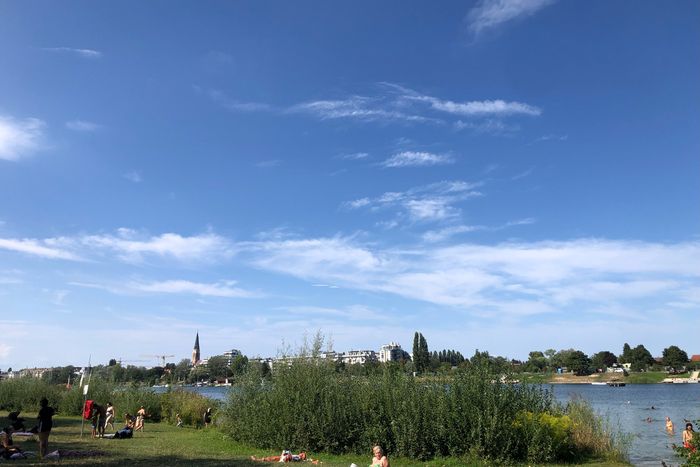

Within Vienna’s city limits are over two square miles of vineyards dotted with heurigen, wine taverns eponymously named after the “young wine” they serve fresh from the vine. The taverns are concentrated in a few different areas, including Nussdorf, a neighborhood at the end of the D tram about 40 minutes from the city center. At the recommendation of a friend, we went to Heuriger Schübel-Auer (Kahlenberger Straße 22, 1190) and were seated in the leafy garden without a reservation (though I’d recommend making one on a weekend evening). We ordered a liter of white wine and sparking water, as is customary, and made spritzes to go along with Austrian snack food (cheese, meat, cucumber salad, roasted tomatoes), which is sold by the pound. Part of the appeal of Nussdorf is strolling through the hillside vineyards, but by the time we got around to this, it was more of a drunken amble. Still, we managed to catch sweeping views of the city and drink one more glass of wine — a final Viennese experience before sleeping for a few hours and heading to the airport for an early morning flight.
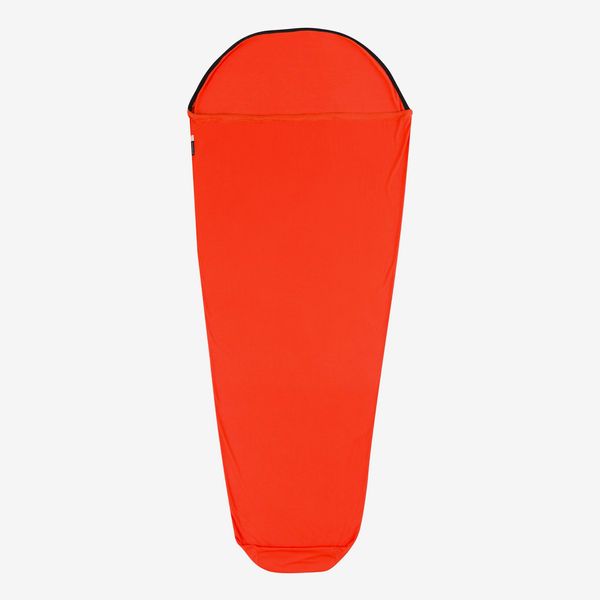
While the huts provide blankets and pillows, this bedding isn’t routinely washed, so guests are required to bring a “hut sleeping bag,” which is basically anything to put under the bedding. This liner, which I’ve used for years on camping trips, keeps you extra warm and weighs less than one pound (since you have to hike with all of your personal belongings, every ounce counts).
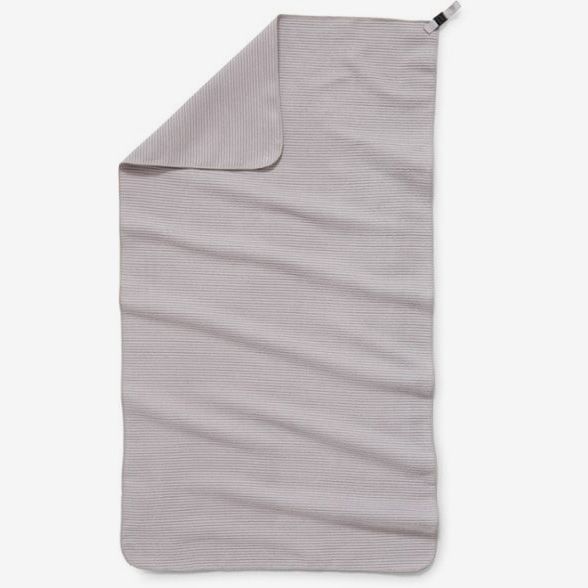
The huts also don’t provide hand or body towels. I got this one in college, and it’s held up on beach days and backpacking trips alike, but any microfiber, packable towel will do (though, if you want to splurge, Nomadix has some actually nice-looking, Dusen Dusen–esque prints).
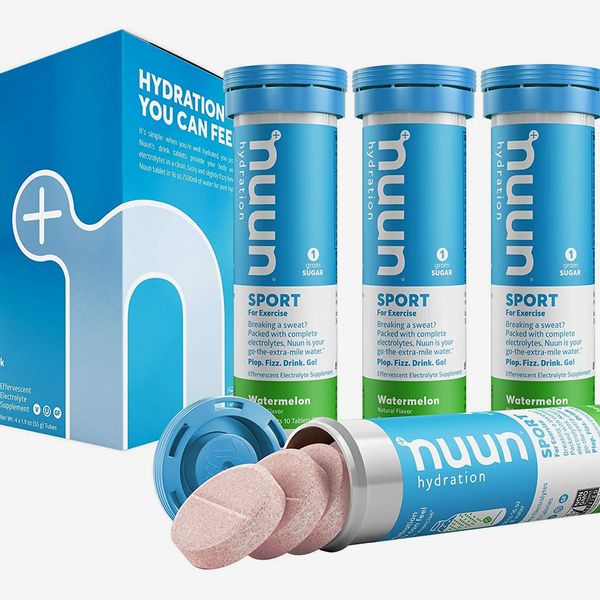
My first water bottle of the day was always filled with one of these tablets for extra hydration and energy. My other toiletry bag must-haves were Aleve, deodorant, and sunscreen.
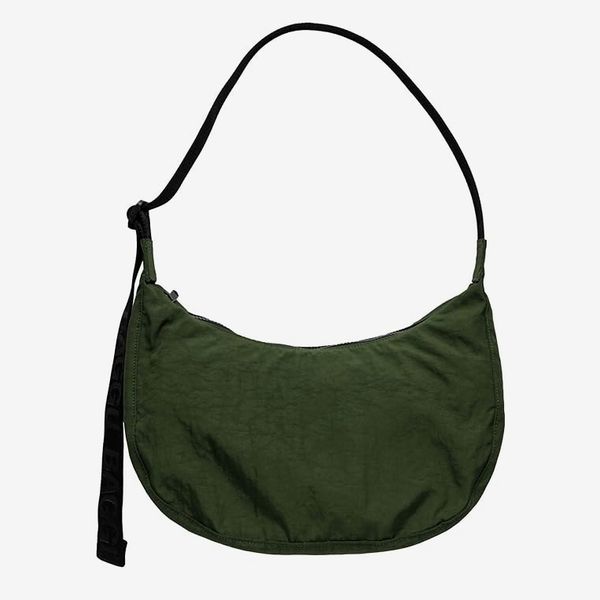
For the days when you’re walking around a city and need something to put a water bottle, book, disposable camera, and extra layer in. My go-to day bag is a small, vintage backpack from my mom, and Jack’s is a crossbody from a defunct California-based outdoor brand, but this bag (which I’ve coveted for a while) comes highly recommended by other travelers. If you plan to stash items in a hotel while on the trail, I’d also suggest bringing an ultralight tote or duffel (ours is from Osprey).
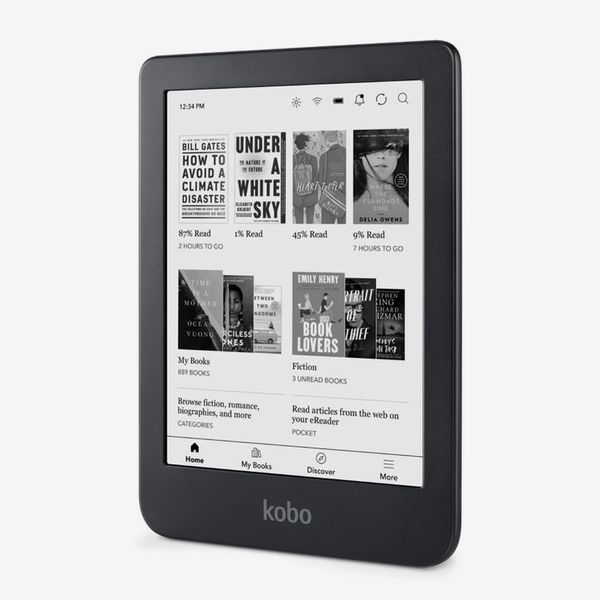
An honorary mention from Jack, who is an extremely minimalist packer but doesn’t travel without this e-reader (my best birthday gift to him yet). We did have a lot of downtime to read (and no Wi-Fi or cell service), so this came in handy. I downloaded and read two full books on my phone but know that’s not everybody’s cup of tea.
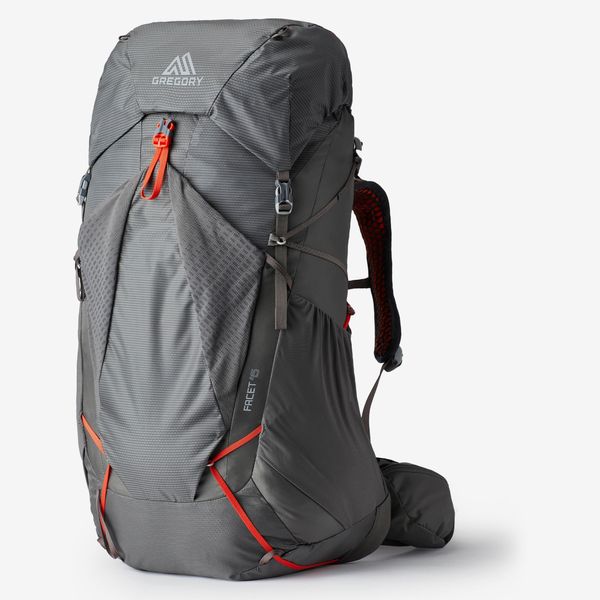
I’ve had the same Deva 60-liter capacity backpack for nearly a decade and can’t say enough good things about it (almost every part of the pack is adjustable, even to my 5-foot-2 frame, and the hip belt is padded). Unsurprisingly, it held up well on this trip, but if I were to do it again (and money was no object), I would spring for a smaller pack. Sixty liters is great for carrying a full load of backpacking gear, but something like this Facet 45-liter pack (which seems to have a lot of the same features as my bag) would suffice for hut-to-hut hiking. Jack was pleased with how his REI 40-liter pack held up, but I don’t like how much weight it puts on your shoulders.
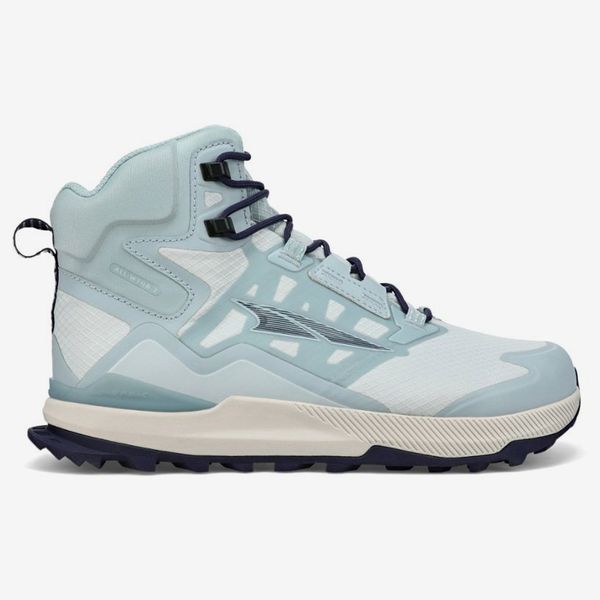
While I stand by my New Balance running shoes for almost all activities (I ran the New York City Marathon in them, for instance), I wouldn’t recommend them for alpine hiking. To put it simply, they lack sufficient traction and ankle support. At the very least, I’d recommend a pair of trail runners. Jack, for instance, wore the Saucony Peregrine 12 without complaint (though he has since mentioned the waterproof version may be better). If I had my pick, I’d choose a pair with more ankle support, like these expert-recommended boots from trail running brand Altra.
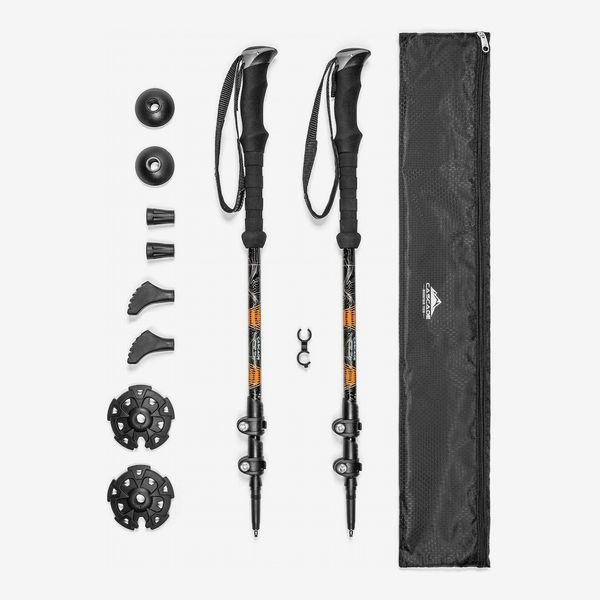
I read a lot of Reddit forums and blogs before this trip, and many suggested that hiking poles were not essential for hiking in the Alps. Let me tell you once and for all: If you are doing any alpine routes, you need a pair of hiking poles. As a beginner, I’d start off with a budget-friendly (but vetted) pair like these. Keep in mind that hiking poles are technically not allowed in a carry-on (though, if you believe what you read on Reddit, this rule is not always enforced).
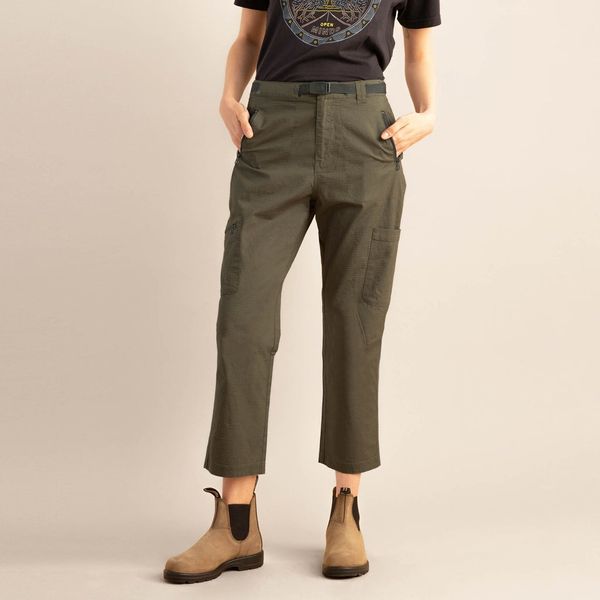
My Athleta leggings got the job done on the trail, but they aren’t a substitute for a pair of hiking pants. I genuinely love the look of this pair from Roark, which has several pockets and a built-in adjustable belt. For a more size-inclusive option, I recommend a cargo or pull-on version from Alder, where I’ve bought durable athletic gear before.
The Strategist is designed to surface the most useful, expert recommendations for things to buy across the vast e-commerce landscape. Some of our latest conquests include the best acne treatments, rolling luggage, pillows for side sleepers, natural anxiety remedies, and bath towels. We update links when possible, but note that deals can expire and all prices are subject to change.

 oujisama
oujisama 